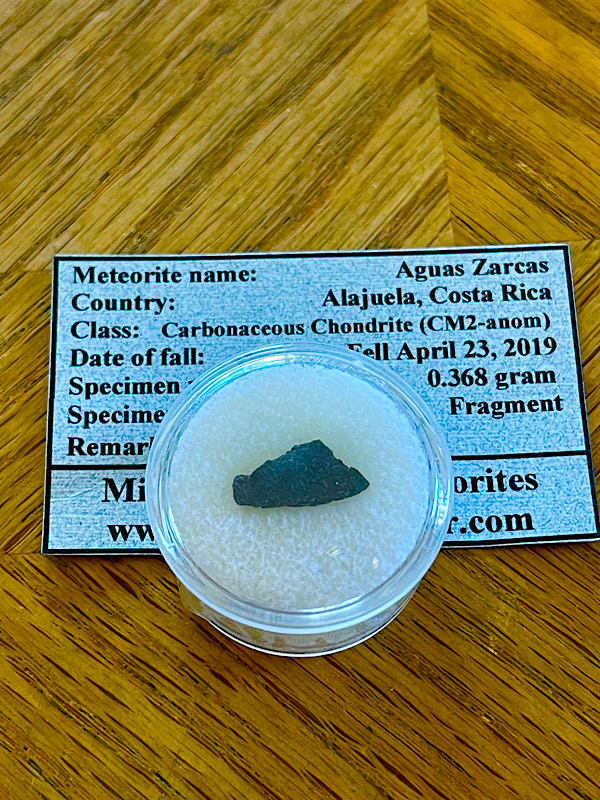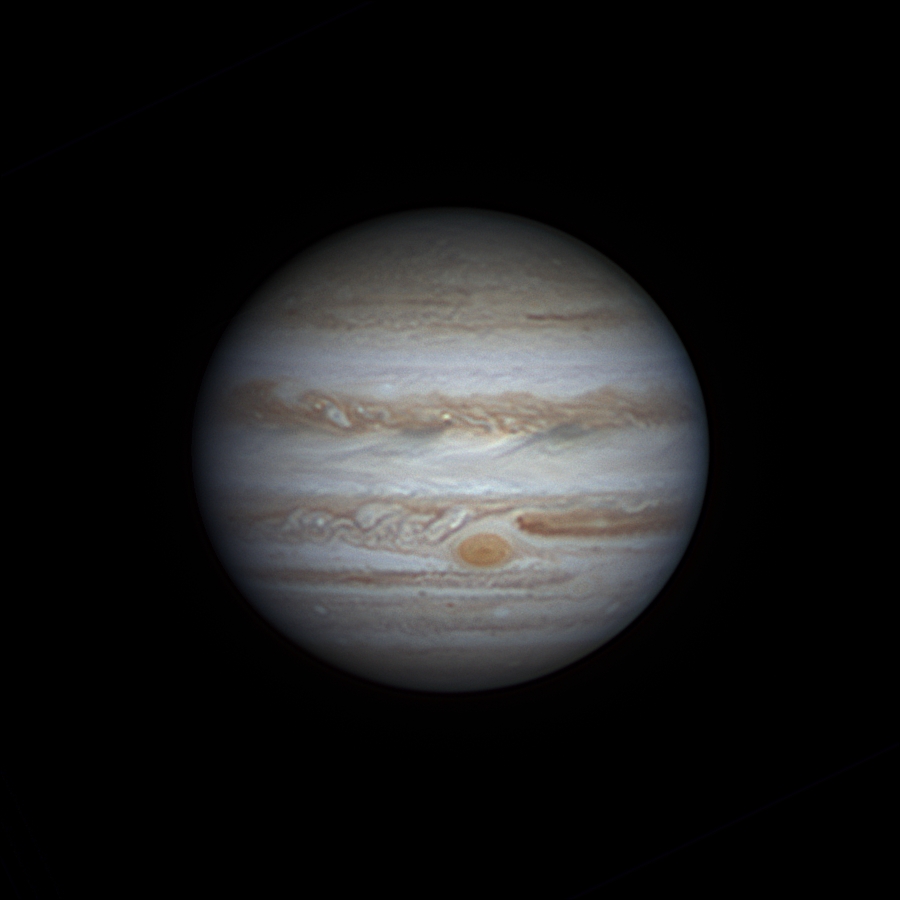|
|
Post by vegasjames on Aug 19, 2023 3:29:18 GMT -5
|
|
ThomasT
has rocks in the head
  
Member since June 2022
Posts: 616
|
Post by ThomasT on Feb 5, 2024 17:21:54 GMT -5
vegasjames Thank you for reposting this news story. I had read of it several years ago and it is fascinating still. As vast as the universe is... beyond our imagination as seen by our new space telescopes... to think that our relatively small rock planet, out of those beyond count, to be the only place in the universe with life is thinking pretty small... I think... Perhaps that was the original source for the primordial life forms here on earth that were the beginnings of the figured silica in some of our most beautiful agates. Who knows?... God is big.
|
|
|
|
Post by vegasjames on Feb 5, 2024 18:04:04 GMT -5
vegasjames Thank you for reposting this news story. I had read of it several years ago and it is fascinating still. As vast as the universe is... beyond our imagination as seen by our new space telescopes... to think that our relatively small rock planet, out of those beyond count, to be the only place in the universe with life is thinking pretty small... I think...  Perhaps that was the original source for the primordial life forms here on earth that were the beginnings of the figured silica in some of our most beautiful agates. Who knows?... God is big. 1dave ? All the building blocks of life have been found in meteorites, and over 100 more amino acids than occur naturally on Earth have been found in meteorites. |
|
|
|
Post by 1dave on Feb 5, 2024 23:57:17 GMT -5
This means there is life on other planets.
|
|
RWA3006
Cave Dweller 
Member since March 2009
Posts: 4,625 
|
Post by RWA3006 on Feb 6, 2024 7:51:39 GMT -5
This means there is life on other planets. It's looking more and more like this, isn't it? |
|
RWA3006
Cave Dweller 
Member since March 2009
Posts: 4,625 
|
Post by RWA3006 on Feb 6, 2024 7:53:13 GMT -5
?[/quote] and over 100 more amino acids than occur naturally on Earth have been found in meteorites.
[/quote]
James, I think you just blew my mind.
|
|
ThomasT
has rocks in the head
  
Member since June 2022
Posts: 616
|
Post by ThomasT on Feb 6, 2024 16:08:48 GMT -5
|
|
|
|
Post by vegasjames on Feb 6, 2024 16:44:15 GMT -5
They should have gold on that list. Most gold nuggets have been known to form due to bacteria for over 40 years.
The first one I ever read about back in high school was Bacillus cereus, which extracts the gold from water plating itself. Then it somehow changes the charge on the gold, which attracts more gold, and the process keeps repeating forming gold nuggets.
Other bacterial species ingest the dissolved gold chloride in the water. This kills the bacteria, but leaves a casting from the bacteria as pule gold. More bacteria attach to this pure gold that is not toxic. These bacteria then ingest more gold chloride killing them and creating a new cast. This leads to the usual god formations with branches or other patterns.
|
|
wargrafix
Cave Dweller 
Member since June 2023
Posts: 1,085
|
Post by wargrafix on Feb 7, 2024 12:29:35 GMT -5
Its a wonderful story!
Gold is formed from the hearts of supernova. So all the gold that we extract originated in the hearts of exploding stars, and became part of our planetary soup that eventually became Earth. I wanted the first image of our 20 inch telescope to be the Orion Nebula. As cliché as it is, The birthplace of stars is the best way to start a journey.
|
|
geoff59
spending too much on rocks
 
Member since October 2022
Posts: 288
|
Post by geoff59 on Feb 7, 2024 12:49:27 GMT -5
When I have the opportunity, I purchase carbonaceous chondrite specimens, they are all so interesting. I have 2 specimens of Zarcas, here is one of them. Doesn’t look like much, does it? Kind of small? The reality is, there is enough material in this 1 specimen to keep a researcher busy for many years. Possibly a career.  There are a lot of scam artists out there when it comes to meteorites, you need to be very careful who you do business with. |
|
|
|
Post by vegasjames on Feb 7, 2024 19:46:02 GMT -5
Its a wonderful story! Gold is formed from the hearts of supernova. So all the gold that we extract originated in the hearts of exploding stars, and became part of our planetary soup that eventually became Earth. I wanted the first image of our 20 inch telescope to be the Orion Nebula. As cliché as it is, The birthplace of stars is the best way to start a journey. Yes, the gold itself forms from the supernova. I was not talking about the gold formation, I was talking about how the gold forms in to nuggets.
One example:
|
|
geoff59
spending too much on rocks
 
Member since October 2022
Posts: 288
|
Post by geoff59 on Feb 8, 2024 4:21:59 GMT -5
Most scientists who study meteorites believe that some carbonaceous chondrites might contain proteins, taking the amino acids content 1 step further. Zarcas samples, the ones collected before they were rained on less than 1 day after the fall, are going to be the focus of the search. The best opportunity of possibly finding one or more. Imagine this, proteins being found in a meteorite! The next few years might get pretty interesting indeed.
|
|
|
|
Post by vegasjames on Feb 8, 2024 7:18:13 GMT -5
|
|
wargrafix
Cave Dweller 
Member since June 2023
Posts: 1,085
|
Post by wargrafix on Feb 8, 2024 9:13:44 GMT -5
Its a wonderful story! Gold is formed from the hearts of supernova. So all the gold that we extract originated in the hearts of exploding stars, and became part of our planetary soup that eventually became Earth. I wanted the first image of our 20 inch telescope to be the Orion Nebula. As cliché as it is, The birthplace of stars is the best way to start a journey. Yes, the gold itself forms from the supernova. I was not talking about the gold formation, I was talking about how the gold forms in to nuggets.
One example:
Ah, It was my mistake. Apologies |
|
ThomasT
has rocks in the head
  
Member since June 2022
Posts: 616
|
Post by ThomasT on Feb 8, 2024 10:19:42 GMT -5
vegasjames I wonder how much of formerly living animals and organisms were ejected from Earth into space when the Earth was struck by the large meteorites or asteroids in the past. I'd guess a bunch of literally blown-up dinosaur era animals (or sea organisms) would spread around a lot of amino acids and such during some of those cataclysmic events on Earth and other worlds out there. Some of that organic material seems probable was encased in molten minerals (or cooked and freeze-dried in space). 1dave
|
|
|
|
Post by vegasjames on Feb 8, 2024 20:12:43 GMT -5
vegasjames I wonder how much of formerly living animals and organisms were ejected from Earth into space when the Earth was struck by the large meteorites or asteroids in the past. I'd guess a bunch of literally blown-up dinosaur era animals (or sea organisms) would spread around a lot of amino acids and such during some of those cataclysmic events on Earth and other worlds out there. Some that organic material seems probable was encased in molten minerals (or cooked and freeze-dried in space). 1dave Interesting concept, but the problem I see that is anything not immediately vaporized would have been turned to a glass from the rapid cooling, such as with tektites, but not meteorites. In addition, such a collision would form impact melts, not consistent with the meteorites that have been found with nucleic acids and other compounds associated with life as we know it.
Many of these things have actually been found in carbonaceous chondrites, which still have intact chondrules. A massive impact that would inject material up in to space would obliterate the chondrules and melt the chondrite, which again with the rapid cooling would convert the chondrite in to glass.
|
|
ThomasT
has rocks in the head
  
Member since June 2022
Posts: 616
|
Post by ThomasT on Feb 8, 2024 20:26:35 GMT -5
vegasjames Perhaps the gigantic space rocks that hit in the Yucatan area (and others) could have thrown up enough water around the outer perimeter of the impact zone to get organic material up and out of there along with the hot water steam... with some of the organic material never having been over-heated. All over the place.
|
|
|
|
Post by 1dave on Feb 8, 2024 20:40:36 GMT -5
All quite possible.
|
|
|
|
Post by vegasjames on Feb 8, 2024 22:20:17 GMT -5
vegasjames Perhaps the gigantic space rocks that hit in the Yucatan area (and others) could have thrown up enough water around the outer perimeter of the impact zone to get organic material up and out of there along with the hot water steam... with some of the organic material never having been over-heated. All over the place. The Murchison meteorite is one of those meteorites, but is is 2.5 million years older than the Earth itself. |
|
geoff59
spending too much on rocks
 
Member since October 2022
Posts: 288
|
Post by geoff59 on Feb 9, 2024 4:14:47 GMT -5
In his book Rocks From Space, O. Robert Norton has a pretty good description of what the impact was like around the globe. The waves generated washed northward to what is now the Dakotas. Pretty much the entire world was set on fire from the heat. I think I’ve read somewhere that those studying the event now think the main object hit at a fairly edge on angle, more tangential, rather than coming more or less straight down from the sky. I’m not entirely sure how something organic or living could survive intact the forces involved if it were knocked literally from Earth’s surface in to space. That’s an interesting thought.
|
|


















